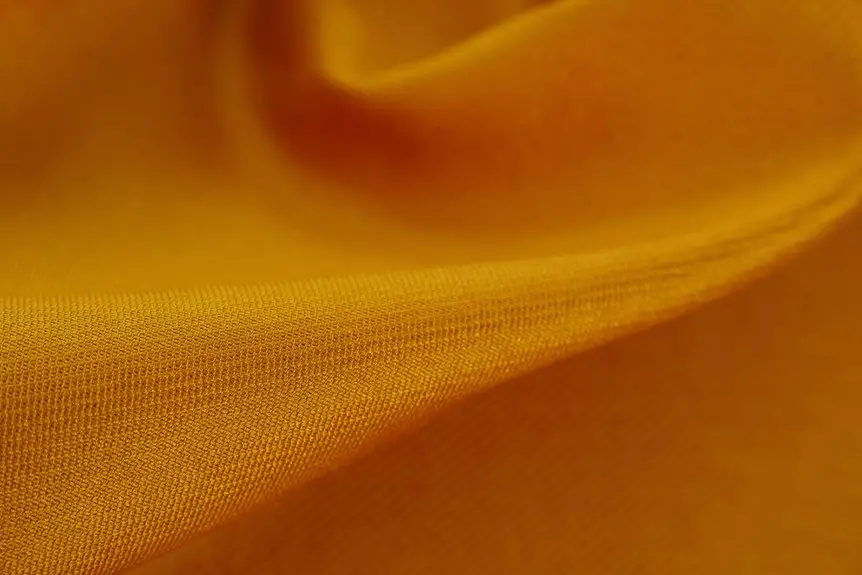You’re drawn to Katan silk because of its luxurious feel and lasting strength. This fabric is crafted from double-twisted pure silk threads, woven tightly using a technique perfected by Indian artisans over centuries. Its dense, plain weave gives it a smooth texture and subtle sheen that resists wear. Katan silk stands out for both its elegance and durability, making it ideal for special garments and decor. There’s much more to discover about its unique history, production, and care.
Table of Contents
Key Takeaways
- Katan silk is a traditional Indian fabric made from tightly twisted pure silk double-twisted yarns for strength and durability.
- It features a dense, uniform plain weave that combines softness with remarkable firmness and subtle natural sheen.
- The fabric is woven using fine warp and weft threads, requiring skilled artisans to maintain consistent tension.
- Katan silk is prized for its resistance to wear and tear, with intricate patterns woven directly into the material.
- It is commonly used in luxury bridal wear, scarves, designer jackets, and exclusive home décor items.
Origins and History of Katan Silk
Although Katan silk has ancient roots, you might be surprised to learn how its unique weaving techniques have evolved over centuries.
You’ll find that Katan silk originated in India, particularly in regions like Varanasi, where skilled artisans perfected its production. This fabric became prized for its fine texture and durability, making it a favorite among royalty and nobility.
As you explore its history, you’ll notice how Katan silk’s reputation grew through trade routes connecting India with the Middle East and Europe.
You’ll also discover how traditional methods have been preserved, even as modern technology influenced silk production.
Understanding the origins and history of Katan silk helps you appreciate its cultural significance and why it remains a symbol of luxury today.
The Unique Weaving Technique Behind Katan Silk
When you examine Katan silk closely, you’ll notice that its exceptional quality comes from a distinctive weaving technique that sets it apart from other silks. This method uses tightly twisted pure silk threads, known as double-twisted yarns, which give the fabric its strength and crisp texture.
You’ll find that the weaver’s skill plays an essential role, as they maintain consistent tension throughout the process. The technique also involves:
- Using a fine warp and weft to create a dense, uniform weave
- Employing a plain weave structure for durability and smoothness
- Carefully controlling thread count for precision
- Finishing the fabric with minimal processing to retain natural sheen
This meticulous approach guarantees Katan silk’s legendary resilience and elegance.
Distinguishing Features of Katan Silk Fabric
Katan silk stands out for its remarkable combination of strength and softness that you can both see and feel. When you run your fingers over it, you’ll notice its smooth texture paired with a firm weave, thanks to the use of doubled silk threads.
This fabric has a subtle sheen that catches the light beautifully without being overly glossy. Unlike other silks, Katan is denser and more durable, making it resistant to wear and tear.
Its tight weave gives it a crisp feel, yet it drapes elegantly. You’ll also spot fine, intricate patterns woven directly into the fabric rather than printed on, highlighting its artisanal quality.
These features make Katan silk uniquely luxurious and long-lasting.
How Katan Silk Is Used in Fashion and Textiles
The unique qualities of Katan silk make it a favorite among designers and artisans alike.
Katan silk’s distinctive charm captivates designers and artisans, making it a timeless fabric choice.
When you choose Katan silk, you’re embracing fabric that adds elegance and durability to your creations. Its fine texture and subtle sheen are perfect for high-end fashion and textiles.
You’ll often find Katan silk used in:
- Bridal saris and lehengas, highlighting intricate embroidery
- Luxury scarves and stoles with rich, vibrant colors
- Designer jackets and blazers that require lightweight strength
- Exclusive home décor items like cushion covers or drapes
Caring for and Maintaining Katan Silk Garments
Because silk fibers are delicate, you’ll need to handle Katan silk garments with care to preserve their beauty and longevity.
Always opt for gentle hand washing in cold water with a mild detergent specifically designed for silk. Avoid wringing or twisting the fabric; instead, press out excess water softly.
When drying, lay your garment flat on a clean towel away from direct sunlight to prevent fading and fiber damage.
Iron your Katan silk on the lowest heat setting while the fabric is slightly damp, and use a pressing cloth to avoid direct contact with the iron.
Store your silk garments in breathable fabric bags to protect them from dust and pests.
Following these steps will keep your Katan silk looking vibrant and luxurious for years.
Frequently Asked Questions
Is Katan Silk Fabric Environmentally Sustainable?
You might not know that silk production uses about 2,000 liters of water per kilogram. While katan silk is natural, it’s not very eco-friendly due to resource-intensive farming and chemical dyes involved in its process.
Can Katan Silk Be Blended With Other Fibers?
You can definitely blend katan silk with other fibers like cotton or wool to enhance durability and texture. This mix keeps the luxurious feel while making the fabric more versatile for different uses and styles.
What Is the Price Range of Katan Silk Fabric?
Wondering how much Katan silk fabric costs? You’ll find prices vary widely—from affordable options around $20 per yard to luxurious, high-quality pieces exceeding $200. Your choice depends on quality, weave, and origin.
Are There Any Regional Variations of Katan Silk?
Yes, you’ll find regional variations of katan silk in India, especially between Varanasi and South India. Each area uses different weaving techniques and patterns, giving the fabric unique textures and designs that reflect local traditions.
How Does Katan Silk Compare to Other Silk Types?
You’ll find katan silk is finer and crisper than other silks like mulberry or tussar. It’s tightly woven, giving it a smooth, glossy finish, making your garments look elegant and durable compared to softer silks.
- Jaclyn Smith Fabric Coconut: a Review of This Rayon/Polyester Blend - June 29, 2025
- Jaclyn Smith Fabric Coconut: a Review of This Rayon/Polyester Blend - June 29, 2025
- How to Get Coconut Oil off Fabric Without Washing - June 29, 2025







